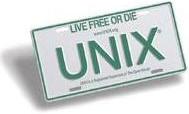UNIX System Home • The Single UNIX Specification • UNIX 03 • UNIX V7 • Mailing Lists • White Papers
UNIX System Home • The Single UNIX Specification • UNIX 03 • UNIX V7 • Mailing Lists • White Papers
Why This is Different |
||

History & TimelineHistory of the UNIX License PlateThe Single UNIX SpecificationRegistered ProductsThe UNIX BrandWhat About All Those "Flavors"Version 2 of the Single UNIX SpecificationVersion 3 of the Single UNIX SpecificationVersion 4 of the Single UNIX SpecificationUNIX API TablesWhy This is Different |
IntroductionIn September 1993, the computer systems industry, in the form of a group of 75 leading system and software vendors, agreed to back an initiative to ask X/Open Company to standardize the specifications of the UNIX operating system. In a parallel move, Novell, Inc. announced that it would transfer the UNIX trade mark, which it owned, to X/Open Company Limited (now part of The Open Group). In a few weeks and two announcements, the computer industry put behind it over 25 years of policy and technical differences to concentrate on delivering a single specification for the UNIX system to the market with the aim of creating a consistent volume market for UNIX systems. All major vendors, including those that would continue to develop and maintain their own implementations of their operating system, agreed that they would ensure that their operating system products would meet a single comprehensive standard specification for APIs (Application Programming Interfaces). This set of specifications would contain about 1170 separate APIs and be derived from those used by the most popular business applications running on UNIX systems. It was therefore able to deliver to market the benefits of a single, standard operating system: application and information portability, flexibility and freedom of choice for customers.
This industry initiative worked through the
proven processes of X/Open Company to develop a set of specifications
by broad industry consensus, supported by a testing and branding
program, that would deliver commonality across multiple implementations
of UNIX systems. The early specification (known then as Spec
1170), took into account the interfaces utilized by the most widely
used UNIX system applications to ensure historical application
compatibility. This Single UNIX Specification now defines products
that are called UNIX, and is backed by the X/Open branding program.
So What's New?Previously the UNIX operating system has been a product with four elements (Figure 1); the specification (e.g. SVID) , the technology (e.g. SVR4), the registered trade mark (UNIX), and the product (e.g. UNIXWare).
 Figure 1 With the Single UNIX Specification, there is now a single, open, consensus specification that defines a product. There is also a mark, or brand, that is used to identify those products that conform to the Single UNIX specification. Both the specification and the trade mark are now managed and held in trust for the industry by X/Open Company. There will be many competing products, all implemented against the Single UNIX Specification, ensuring competition and vendor choice. There will be a limited number of technology suppliers, which vendors can licence and build their own product, all of them implementing the Single UNIX Specification. Buyers can expect each of these products to carry the X/Open UNIX brand as an guarantee of conformance to the specification and that the vendor stands behind a quality product. UNIX is now no longer just the operating system product from AT&T (later, Novell), documented by the System V Interface Definition (SVID), controlled and licensed from a single point. Neither is it a collection of slightly different products from different vendors, each extended in slightly different ways. The UNIX specification has been separated from its licensed source-code product, and "UNIX'' has become a single stable specification to be used to develop portable applications that run on systems conforming to the Single UNIX Specification Portability is ensured because the single set of APIs is supported on all branded products. Customers benefit from flexibility and freedom of choice because they are now able to build large scale systems using 'best of breed' products. Work on defining and agreeing the exact content of the Single UNIX Specification began towards the end of 1993 and was completed in the third quarter of 1994. In parallel with this activity, X/Open Company extended its branding program to include UNIX system products that meet the specification and conformance requirements. In joining the program and branding its products a vendor warrants and represents that any branded product: conforms to the specification; will continue to conform to the specification; and if there is a non-conformance it will be rectified in an agreed time. To support the branding program, X/Open has developed a comprehensive set of software test tools. These test suites are used by the vendor to help ensure that the vendor has the confidence to stand behind the guarantee that they give when branding their products.
|
|